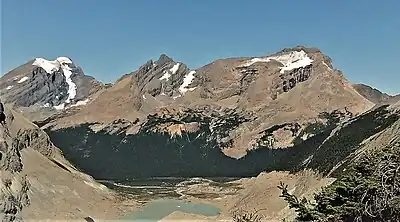| Mount Anne-Alice | |
|---|---|
 Mt. Anne-Alice centered, from southeast. Mt. Phillips (left), subsidiary of Mumm Peak (right) | |
| Highest point | |
| Elevation | 2,941 m (9,649 ft)[1] |
| Prominence | 262 m (860 ft)[2] |
| Parent peak | Whitehorn Mountain (3,399 m)[2] |
| Isolation | 3.8 km (2.4 mi)[2] |
| Listing | Mountains of British Columbia |
| Coordinates | 53°10′48″N 119°12′09″W / 53.18000°N 119.20250°W[3] |
| Geography | |
 Mount Anne-Alice Location in British Columbia  Mount Anne-Alice Mount Anne-Alice (Canada) | |
| Country | Canada |
| Province | British Columbia |
| District | Cariboo Land District |
| Protected area | Mount Robson Provincial Park |
| Parent range | Canadian Rockies → Park Ranges |
| Topo map | NTS 83E3 Mount Robson[3] |
| Climbing | |
| First ascent | 1939 |
Mount Anne-Alice is a mountain summit in the Canadian Rockies of British Columbia, Canada.
Description
Mount Anne-Alice is located on the Continental Divide just inside the Mount Robson Provincial Park boundary.[4] It is situated on the northwest side of Berg Lake with precipitation runoff from the peak draining into the lake and Robson River. Topographic relief is significant as the summit rises 1,300 m (4,300 ft) above the lake in 4.5 km (2.8 mi). The nearest neighbor is Mumm Peak, 3.8 km (2.4 mi) to the east.[2] The mountain is composed of sedimentary rock laid down during the Precambrian to Jurassic periods and pushed east and over the top of younger rock during the Laramide orogeny.[5]
History
The first ascent of the summit was made in 1939 by Anne MacLean Chesser and Alice Wright.[4] They named the mountain after themselves since they found no evidence of a prior ascent. They built a stone cairn at the summit and claimed first ascent. Anne MacLean was a partner in the tourism and outfitting business at Mount Robson. Alice Wright was a frequent visitor at Berg Lake Chalet through the 1930s and 40s and was a well-known member of the tourism/outfitting industry throughout the Rockies.[1] Alice was known to climbers as the "Mother Confessor of Mount Robson" because they would consult her before their ascents since she knew so much about the mountain.[6] The mountain's toponym was officially adopted December 7, 1990, by the Geographical Names Board of Canada.[3]
Climate
Based on the Köppen climate classification, Mount Anne-Alice is located in a subarctic climate zone with cold, snowy winters, and mild summers.[7] Winter temperatures can drop below −20 °C with wind chill factors below −30 °C. This climate supports the Mural and Hargreaves glaciers on the peak's slopes.
See also

References
- 1 2 "Mount Anne-Alice". cdnrockiesdatabases.ca. Retrieved 2023-01-04.
- 1 2 3 4 "Mount Anne-Alice, Peakvisor.com". Retrieved 2023-01-04.
- 1 2 3 "Mount Anne-Alice". Geographical Names Data Base. Natural Resources Canada. Retrieved 2023-01-04.
- 1 2 "Mount Anne-Alice". BC Geographical Names. Retrieved 2023-01-04.
- ↑ Gadd, Ben (2008), Geology of the Rocky Mountains and Columbias
- ↑ Gooch, Jane Lytton (2013). Mount Robson: Spiral Road of Art. Rocky Mountain Books. p. 90. ISBN 9781927330609.
- ↑ Peel, M. C.; Finlayson, B. L.; McMahon, T. A. (2007). "Updated world map of the Köppen−Geiger climate classification". Hydrol. Earth Syst. Sci. 11: 1633–1644. ISSN 1027-5606.
External links
- Mount Anne-Alice: weather forecast
- Mount Robson Provincial Park—BC Parks